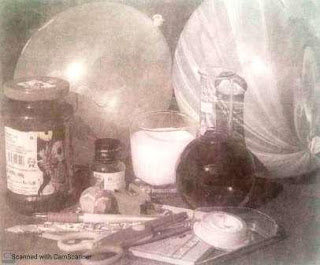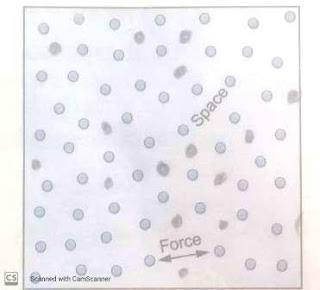[Study material]Matter in our surroundings
There are a large number of things around us which we see
and feel. For example, you can see this post in front of you. This post
occupies some space. The space occupied by the ball is called its volume. If
you pick up the ball, you can also feel its weight. So, you conclude that the book has some mass. You
cannot see the air around you, yet if you feel a balloon with year and then weight it carefully, you will find that
it not only does Air occupy space (
bonded by the balloon), but it also has mass. Things like ball and air are
example of matter. Other example of matter are wood, cloth, paper, ice, steel,
water, oil, etc. further, that matter offers resistance in borne out by the
fact that you cannot display an object from one place to another without
applying some forces. You have to apply force to pick up a stone from the
ground. On the contrary, light, heat, sound, electricity, etc., are not matter
because they do not have any mass and they do not occupy space.
Thus, matter
can be defined as follows.
Anything that occupies space, has mass and offers resistance
is called matter.
What is substance.
A substance is a kind of matter that can’t be
separated into other kinds of matter by any physical process. For example,
sugar dissolved in water be separated from water by simply evaporating the
water. Here, sugar is a substance which can’t be broken into its component by
any physical process. Similarly, sodium chloride, lime (calcium oxide), etc., are
all substances.
Physical nature of matter.
1. Matter is made up particles
The ancient philosophers held the view that matter is
continuous, like a block of wood. But this is not true. Actually, matter is
made up of discrete particles. This can be easily e verified by performing the
following activity.
Take care a
beaker. Fill half of it with water. Mark the level of water in the beaker.
Address of sugar to the water and dissolved it with the help of a glass rod.
You will see that the sugar has disappeared, but there is no change in the
level of water. Can you say a where has the sugar gone? This can be explained
by assuming that matter is not continuous,rather it is made up of particles.
Sugar contains a large number of separate particles. These particles when
dissolved in water occupies the space between the particles of water. That is
why the water level in the beaker did not rise. Had sugar been continuous, like
a block of wood, the water level in the beaker would have risen.
2. The particles of matter are too small to be imagined
This can be explained by performing the following activity.
Step 1 take some crystals of blue vitriol (copper sulphate)
and dissolve them in 100 ml of water. The solution will go blue.
Step 2 take about 10 ml of the blue solution prepared in
step 1. Add it to another hundred ml of face water.
Step 3 take about 10 ml of the solution prepared in step 2.
Add it to another 100 ml of fresh water.
In this way, repeat the exercise 5 to 8 times. You will find
that the last solution is a steel blue though the intensity of the colour has
gradually decreased.
This indicates that a few crystals of copper sulphate are
able to colour and enormously large volume of water. This also shows that a
small crystal of copper sulphate contains millions of small particles.
3. The particles of some matter are in constant motion
The following activity shows that the particle of some
matter are always moving.
Put an incense
stick (agarbati) in a corner of your room. You can’t get it smell from a
distance. For that, you have to move closer to it. Now, light the stick with a
matchstick. You can now get its smell even if you are sitting at a distance.
Why? The particles of perfume present in the incense stick freely mixed with
the particles of air and have a speed across the room. Is the particles where
not movie, the smell of the incense stick would never have recharged you.
4. The particle of matter attract each other
The particles
of matter are held Together by a force acting between them. This force is
called intermolecular force of attraction.
The strength of
the intermolecular force of attraction differs from matter to matter.
Take an iron nail, a stick of Chalk and a small pieces of
brick. Strike each of them separately with a hammer. You will observe that the
stick of Chalk gets broken into pieces easily, the piece of brick brakes but
not so easily, but it is most difficult to break the iron nail. What do these
observations say? It is clear that the particles of iron nail are held Together
by the strongest force followed by the pieces of brick, whereas the particle of Chalk have the weakest force of attraction.
5. The particle of matter have empty space between them
During the dissolution of sugar in water the particle of
sugar occupy the important space between the particles of water. The Imperial
space is called intermolecular space or intermolecular volume.




No comments:
Post a Comment